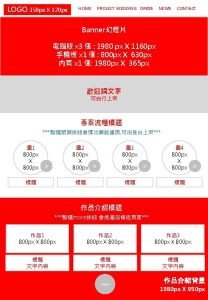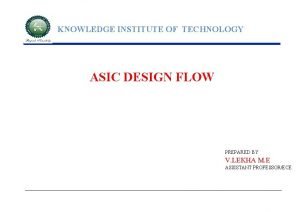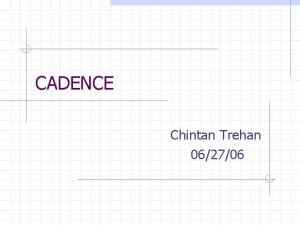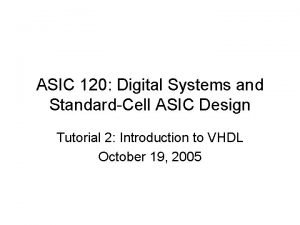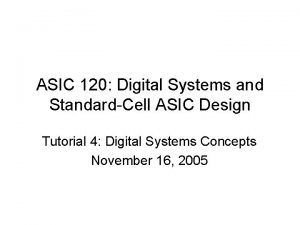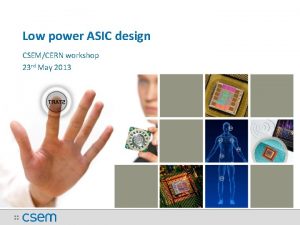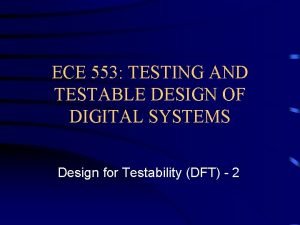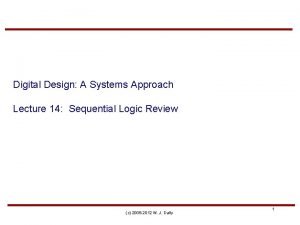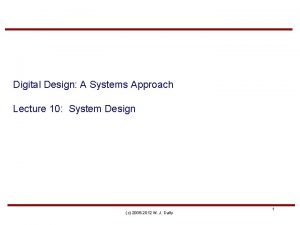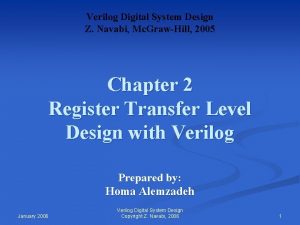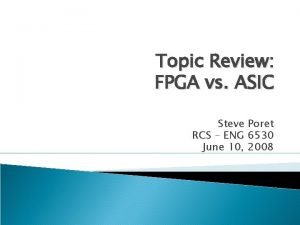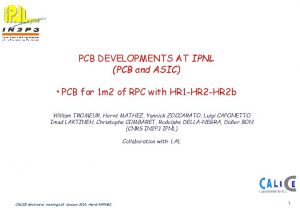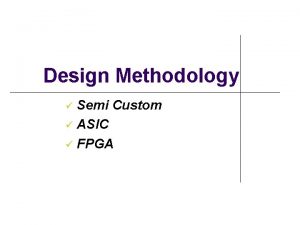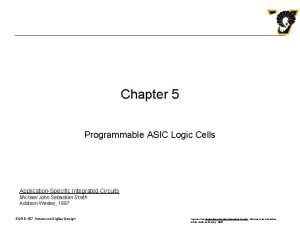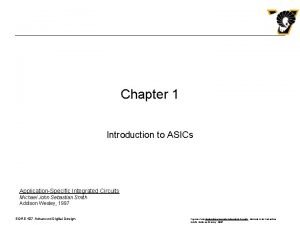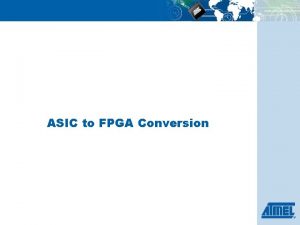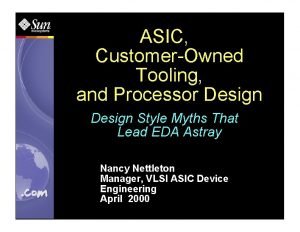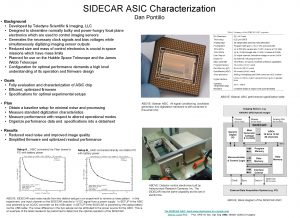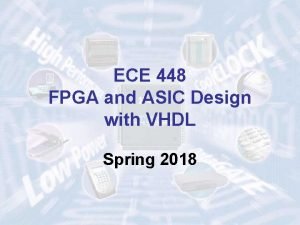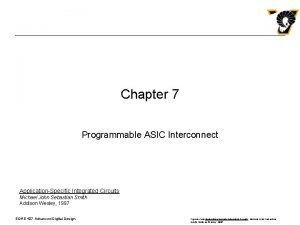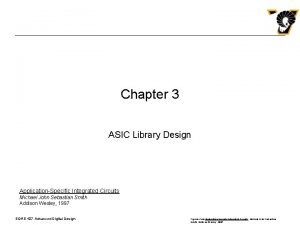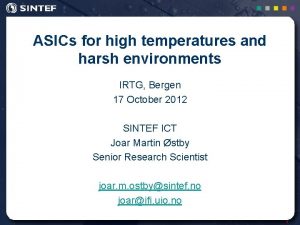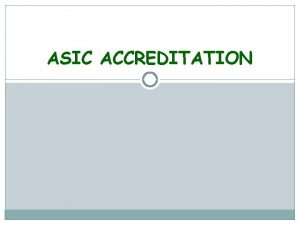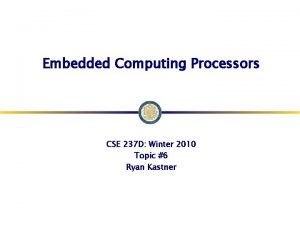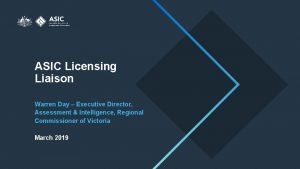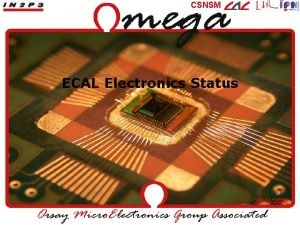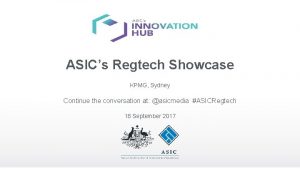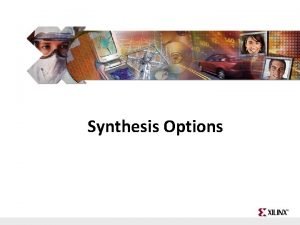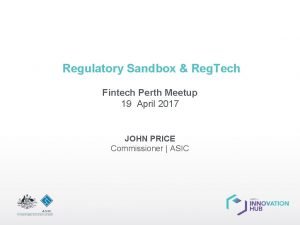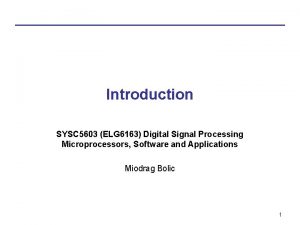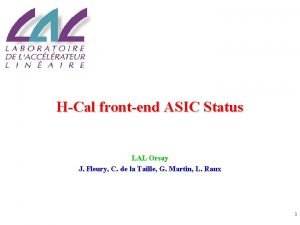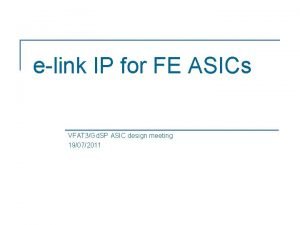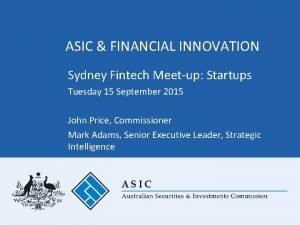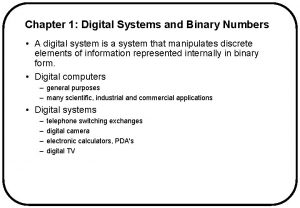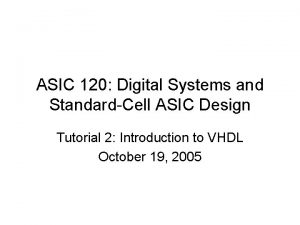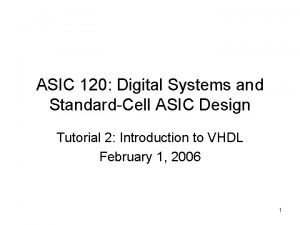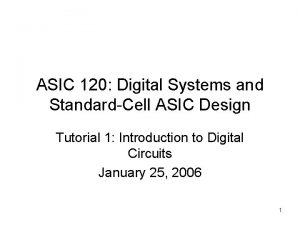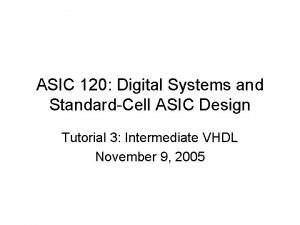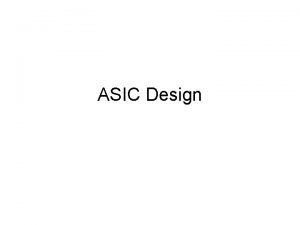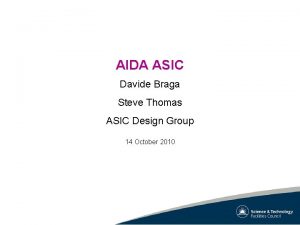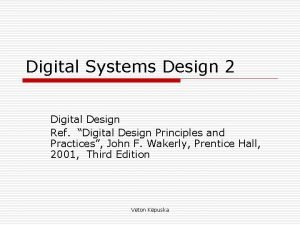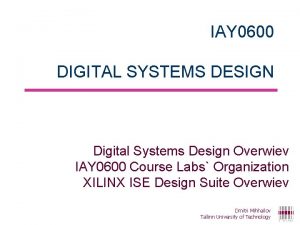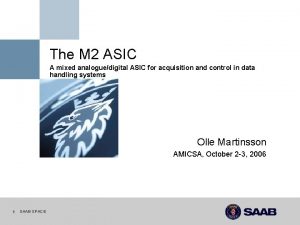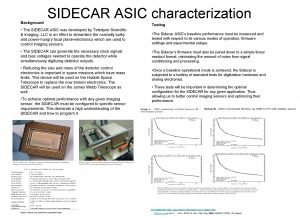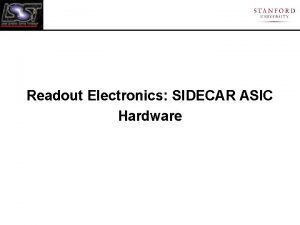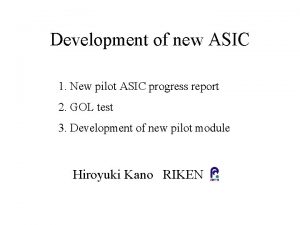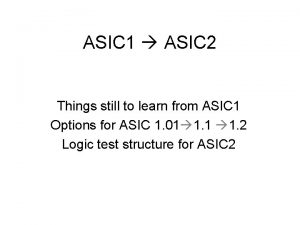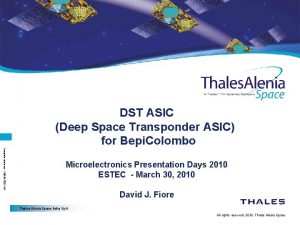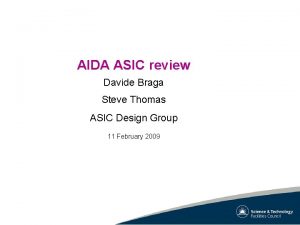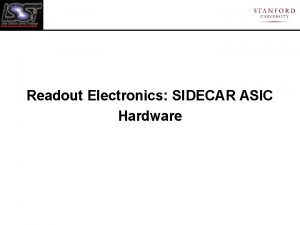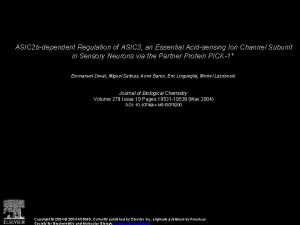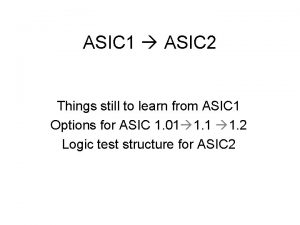ASIC 120 Digital Systems and StandardCell ASIC Design












































- Slides: 44

ASIC 120: Digital Systems and Standard-Cell ASIC Design Tutorial 4: Digital Systems Concepts November 16, 2005

Outline • Summary of previous tutorial • The FPGA: LEs, buffers and routing • Other FPGA resources: clocks, memories, memory interfaces, multipliers, etc. • Soft- and hard-processors in FPGAs • Bus interfaces • Register files

Summary of Previous Tutorial • • • Other signal values besides ‘ 0’ and ‘ 1’ More VHDL data types Attributes, type definitions Generics Splitting a VHDL project across multiple design units and files • if … generate, for … generate • VHDL 1987 vs. 1993 vs. 2000 • Test benches – time, procedures, variables, file access, etc.

The FPGA • FPGA stands for Field Programmable Gate Array – reprogrammable hardware • FPGAs contain – Logic Elements (LEs) which do calculations – Routing resources between LEs – Other specialized functions (memory, multipliers, etc. )

The FPGA: Origins • The FPGA is the latest in the family of Programmable Logic Devices (PLDs) • First came the Programmable Logic Array (PLA) or Programmable Array Logic (PAL) – implements combinational (non-clocked) logic using array of AND and OR gates – hundreds to thousands of gates • Then, the Complex Programmable Logic Device (CPLD) – ability to do sequential circuits – unlike FPGAs, non-volatile – thousands to tens of thousands of gates • Field Programmable Gate Array (FPGA) – tens of thousands to millions of gates – often include other resources besides pure logic

FPGA vs. ASIC • FPGA – reprogrammable – cheap in small quantities • ASIC – mistakes are costly and time consuming to fix – cheap in large quantities – better power consumption – smaller for same functionality

FPGA vs. PSo. C or So. C • System on a Chip (So. C) or System on a Programmable Chip (PSo. C) – Integrates several functional blocks onto one silicon wafer • Could include – – – – Microprocessor RAM, ROM, EEPROM USB interface Ethernet interface Graphics controller DSP etc.

FPGA vs. PSo. C or So. C • So. C is implemented in an ASIC • PSo. C is implemented in an FPGA • Another alternative: “Structured ASICs” – Pre-fab ASICs that take a design implemented and tested in an FPGA and put it into an ASIC • Example: Altera Hard. Copy and Hard. Copy II – http: //altera. com/products/devices/hardcopyii/hr 2 -index. jsp • Features – Power usage and speed characteristics of an ASIC – Time from order to production can be as fast as several weeks (as opposed to months for an ASIC) – Cost savings

The FPGA

The FPGA

The FPGA

An FPGA Datasheet • Datasheets of any ASIC contain detailed specifications and technical data – FPGAs are no exception • Before you start any design, know the FPGA resources – – – size limitations speed limitations number of I/O pins clock pins and resources special features • You can never have enough FPGA resources

Components of an FPGA • • Logic Elements (LEs) Routing Input/Output logic Extra features – clocking – memory interfaces – multipliers

The Logic Element • Two main parts – Look-Up Table (LUT) – Flip Flop (FF) • Other characteristics – – – load/clear logic carry chain logic LUT/FF bypass logic clock enable other routing

The Logic Element • Look-Up Table – generally four inputs and one output – can implement any four input boolean expression • LEs maintain their configuration while power is applied to the FPGA – need to be re-programmed after power-up or global reset, and before using

Routing • Routing logic connects LEs to – other LEs – specialized FPGA resources – input/output pins • Different kinds of routing logic – short lines – long lines – carry chains – clock routing

How a Design Goes from VHDL to FPGA • Synthesis ( “compilation”) – VHDL to intermediate representation • Translate – intermediate representation mapped to LUTs and FFs • Map – fit translated design into available resources on FPGA • Place and Route – place mapped LUTs and FFs into locations on FPGA – determine best routing subject to timing constraints • Programming – generate a bit stream (binary file) which can be loaded into the FPGA at programming time

How a Design Goes from VHDL to FPGA • This entire process is extremely nondeterministic – much more so than software compilation • Terms and steps on previous slide are “generic” – individual FPGA companies have their own terms and slightly different design flows

Input/Output Logic • I/O buffers – input – output – tri-state (“output enable”) • Specialized I/O – memory interfaces – high speed differential signalling • Modern FPGAs can be wired directly (with appropriate analog support components) to – – RAM chips 10/1000 Base-T Ethernet SD-SDI, HD-SDI drivers (up to 1. 5 Gbps) etc.

Extra FPGA Features • Clock features – Phase/Delay Locked Loops (PLLs/DLLs) – Special routing resources • Memory – Block RAM – Distributed RAM • Memory interfaces – SD-RAM, DDR 2, etc. – Configuration devices • Multipliers

Clocks • Modern FPGAs feature multiple onboard PLLs that can be used for – phase/frequency synchronization – frequency multiplication – arbitrary duty cycles • Clock routing logic – dedicated clock lines that run to all LEs – reduce clock jitter and skew • Generally external clocks must be connected to one of several special pins to use these features

Memory

Block RAM

Distributed RAM

RAM Inference

Memory Interfaces

FPGA Configuration • What happens to an FPGA on power-up? – LEs and RAM values are random, or some initialization value such as all 0 • An FPGA must be configured before it can be used – Configured by a microprocessor – Dedicated configuration device – CPLD using a non-volatile Flash RAM device

Multipliers

Hard- and Soft-Processors

Soft Processor Exmple: Altera NIOS-II

Hard Processor Example: Power. PC

Interfacing with FPGA Features in VHDL

Buses • A bus allows multiple entities to communicate over the same “wires” • External buses interface between physical ASICs or FPGAs • Internal buses interface between different components within an ASIC or FPGA

An Idle Bus

Bus Read Cycle

Bus Write Cycle

External Bus Interfaces

Internal Buses • Separate read and write buses

Buses: What I’ve Skipped • Bus arbitration – multiple masters • Direct Memory Access (DMA) – Bus mastering • See the E&CE 324 course notes for more on buses

Register Files • Also called register blocks

What I’ve Skipped • Blocks, Libraries/Packages – other modularity features – we’ve had a taste of libraries and packages: library ieee; … • Configurations – way to select among multiple architectures • Constants – like generics, but within one file • File access – useful for test benches, not synthesizable • Functions, procedures, variables

Preview of Next Tutorial • Digital Systems Concepts – The FPGA: LEs, buffers and routing, other resources – Bus interfaces – Register files – Other FPGA resources: clocks, memories, memory interfaces, multipliers, etc. – Soft- and hard-processors in FPGAs

Summary • • • Summary of previous tutorial Other signal values besides ‘ 0’ and ‘ 1’ More VHDL data types Attributes, type definitions Generics Splitting a VHDL project across multiple design units and files • if … generate, for … generate • VHDL 1987 vs. 1993 vs. 2000 • Test benches – time, procedures, variables, file access, etc.

UW ASIC Design Team • www. asic. uwaterloo. ca • reference material – Accolade VHDL reference (excellent!): http: //www. acc-eda. com/vhdlref/ • many of today’s examples came from here – Bryce Leung’s tutorials (UW ASIC website) – Mike Goldsmith’s tutorials (UW ASIC website) – your course notes • my contact info: Jeff Wentworth, jswentwo@engmail. uwaterloo. ca
 Px home
Px home 160+140
160+140 Asic design flow
Asic design flow Ic design flow
Ic design flow Asic design flow tutorial
Asic design flow tutorial Asic design tutorial
Asic design tutorial Low power asic design
Low power asic design Digital systems testing and testable design
Digital systems testing and testable design Digital design: a systems approach
Digital design: a systems approach Digital design: a systems approach
Digital design: a systems approach Digital systems design using verilog
Digital systems design using verilog Microcontroller vs fpga
Microcontroller vs fpga Unique features of digital markets
Unique features of digital markets Fpga vs asic
Fpga vs asic Asic pcb
Asic pcb Semi custom asic
Semi custom asic Programmable asic
Programmable asic Gate array based asic
Gate array based asic Fpga to asic conversion
Fpga to asic conversion Cot asic
Cot asic Sidecar asic
Sidecar asic Sidecar asic
Sidecar asic Ece 448
Ece 448 Xilinx lca
Xilinx lca Aoi221
Aoi221 High temperature asic
High temperature asic Asic accreditation
Asic accreditation Asip vs asic
Asip vs asic Afslapplications
Afslapplications Asic
Asic Electronics
Electronics Asic regtech
Asic regtech Asic
Asic Sandbox framework
Sandbox framework Sysc
Sysc Cr rc shaper
Cr rc shaper 3gd chip
3gd chip Asic innovation hub
Asic innovation hub Horarios upv
Horarios upv Structured asic
Structured asic Advantages of digital computers
Advantages of digital computers Digital systems and binary numbers
Digital systems and binary numbers Introduction to digital control system
Introduction to digital control system Decision support systems and intelligent systems
Decision support systems and intelligent systems Kendall and kendall terminology
Kendall and kendall terminology
